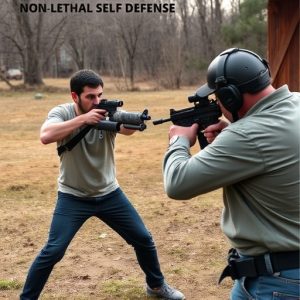Projectile vs Contact Stun Weapons: LED Flashlight’s Role in Defense
Tactical stun guns with integrated LED flashlights offer a versatile, safer alternative to firearms…….
Tactical stun guns with integrated LED flashlights offer a versatile, safer alternative to firearms for personal defense and security. These devices utilize electric shocks through metal prongs to incapacitate assailants upon direct contact, with dual functionality enhancing user safety. The "tactical stun gun with LED flashlight" combines powerful neutralization with high-intensity lighting, useful in low light or complete darkness. Both projectile and contact stun weapons serve distinct purposes; while projectile tools maintain distance, contact weapons offer immediate deterrence at close range. Safe use requires training to prevent injuries, and legality varies across jurisdictions, necessitating compliance with local laws.
In the realm of personal defense, stun weapons have emerged as game-changers. This article delves into the intricate world of projectile and contact stun devices, offering a comprehensive guide for citizens seeking self-protection. We explore how projectile weapons utilize force without physical contact, while contact stun devices deliver direct impact. Additionally, we introduce tactical stun guns with LED flashlights, combining functionality. Understanding these options is crucial when navigating legalities and ensuring safety in today’s diverse threat landscape.
- Understanding Projectile Stun Weapons: How They Work and Their Advantages
- Contact Stun Devices: Direct Impact and In-Depth Analysis
- Tactical Stun Guns: A Hybrid Approach, Combining LED Flashlight and Stunning Capabilities
- Application and Use Cases: When to Choose Each Type
- Safety Considerations and Legal Aspects of Owning Stun Weapons
Understanding Projectile Stun Weapons: How They Work and Their Advantages
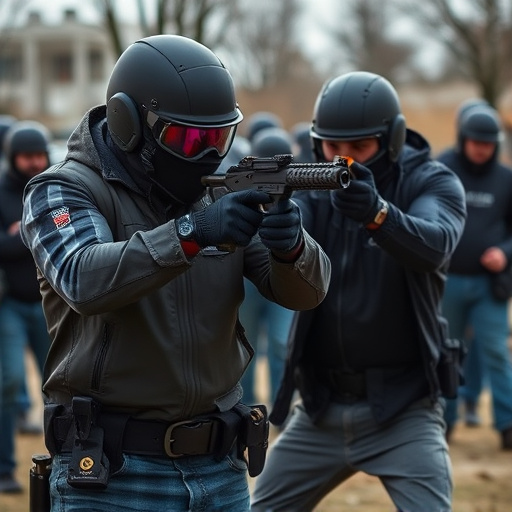
Projectile stun weapons, also known as non-lethal or less-than-lethal force tools, operate by using technology such as electric current, chemical agents, or kinetic force to temporarily incapacitate a target. One of the most common examples is the tactical stun gun with LED flashlight, which fires an electrical charge at the assailant, causing muscle spasms and temporary paralysis. This type of weapon is designed to subdue an attacker without causing permanent harm, making it a popular choice among law enforcement agencies for crowd control and self-defense scenarios.
The advantages of projectile stun weapons are numerous. They offer a safer alternative to firearms, as they do not carry the risk of fatal injuries. This reduces potential bystander harm and legal repercussions. Additionally, tactical stun guns with LED flashlights provide a versatile tool for various situations, from personal security to public safety management. Their non-lethal nature makes them ideal for de-escalation tactics, allowing individuals to regain control without resorting to deadly force.
Contact Stun Devices: Direct Impact and In-Depth Analysis
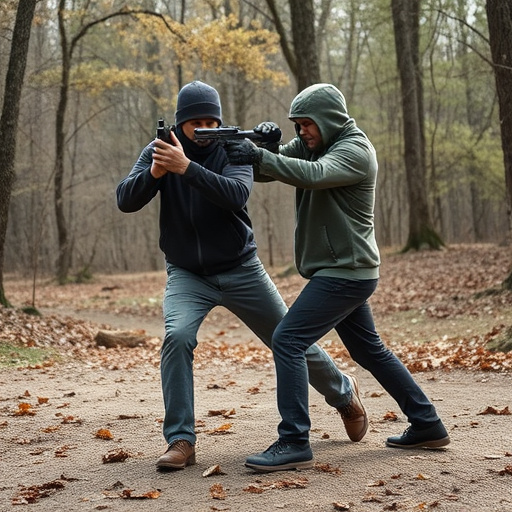
Contact stun devices, often referred to as stun guns or tactical stun weapons, operate by delivering an electric shock to neutralize an assailant. Unlike projectiles, which rely on distance and impact, these devices require direct contact for their effectiveness. When deployed, they emit a high-voltage, low-current electrical discharge through metal prongs or contacts, disrupting muscle control in the target’s body, leading to temporary incapacitation.
A tactical stun gun with LED flashlight combines the power of a stun device with the utility of a light source. This dual functionality enhances user safety and versatility, making it a preferred choice for law enforcement officers, security personnel, and individuals seeking personal protection. The direct impact nature of contact stun devices ensures their reliability in close-quarters situations, where speed and precision are paramount.
Tactical Stun Guns: A Hybrid Approach, Combining LED Flashlight and Stunning Capabilities
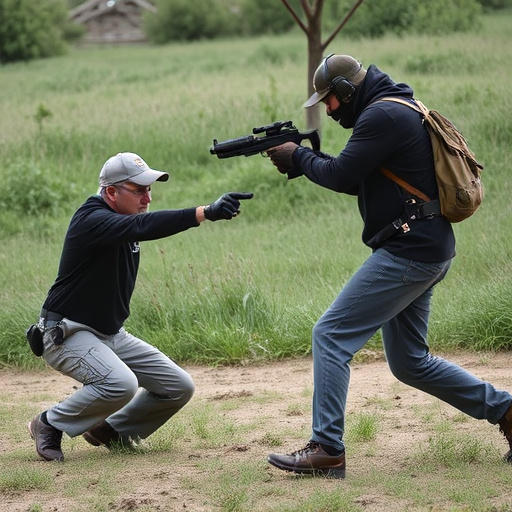
Tactical stun guns represent a clever hybrid approach in personal defense, seamlessly combining the power of a stun device with the versatility of an LED flashlight. These innovative tools offer law enforcement officers, security personnel, and civilians alike a versatile option for self-defense situations. By integrating a high-intensity LED light source with electroshock technology, users gain the ability to illuminate dark areas while simultaneously neutralizing threats.
The tactical stun gun with LED flashlight provides a multi-functional device that enhances situational awareness and deterrence. The bright beam of light can temporarily blind an attacker, giving the user precious time to assess the situation or make a swift escape. Moreover, the stun functionality ensures that even in complete darkness, the device remains effective, delivering a powerful electric shock to incapacitate an aggressor. This hybrid design offers a practical solution for individuals seeking a portable and versatile self-defense mechanism.
Application and Use Cases: When to Choose Each Type
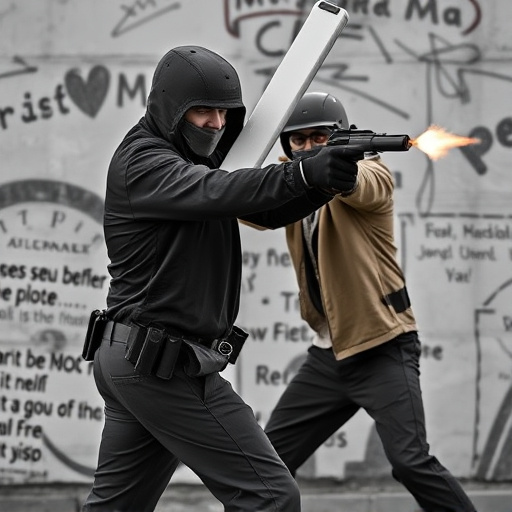
In the realm of personal defense, both projectile and contact stun weapons offer unique capabilities catering to distinct needs. Projectile stun devices, such as stun guns or tasers, are ideal for maintaining a distance between the user and the assailant. These tools are particularly useful in scenarios where quick incapacitation is required without direct physical contact, such as during high-risk situations involving armed suspects or when de-escalation calls for a tactical approach from a safe distance. For instance, law enforcement officers often opt for stun guns equipped with LED flashlights, enhancing their versatility in low-light conditions.
Conversely, contact stun weapons, like electroshock shields or hand-held tasers designed for close-quarters combat, excel when immediate physical deterrence is paramount. These devices are effective for neutralizing attackers at close range, providing a powerful option for self-defense scenarios where the user must confront an assailant face-to-face. The choice between these weapon types depends on factors like the potential threat’s distance, the environment, and the user’s training and comfort level with each approach.
Safety Considerations and Legal Aspects of Owning Stun Weapons

The safety considerations for stun weapons, whether tactical stun guns with LED flashlights or other contact/projectile devices, are paramount. Unlike traditional firearms, stun guns do not fire projectiles and are designed to deliver a powerful electrical shock, rendering a target temporarily incapacitated. However, this unique mode of force application introduces distinct challenges. Users must be meticulously trained in their proper use, as incorrect deployment could lead to unintended injuries or even death, particularly when dealing with individuals with medical conditions or those under extreme stress.
Legally, the ownership and carrying of stun weapons are subject to stringent regulations that vary widely between jurisdictions. Some areas prohibit the possession of any stun device, while others allow them only for specific professions like law enforcement or private security. Additionally, restrictions on voltage levels, charge capacities, and the inclusion of LED flashlights can impact legality. It’s crucial for prospective buyers to thoroughly research and comply with local laws to avoid legal repercussions, ensuring a safe and responsible environment for all.
When considering a personal defense tool, understanding the differences between projectile and contact stun weapons is crucial. Projectile options offer a non-lethal way to create distance between you and a threat, while contact devices deliver immediate impact when direct contact is made. The tactical stun gun with LED flashlight combines these elements, providing both a powerful flash light for visibility and a stun charge for close-quarters defense. Depending on your needs and legal jurisdiction, each type offers unique advantages. Always prioritize safety and familiarize yourself with local laws regarding stun weapon ownership and use.


